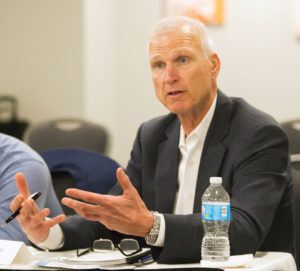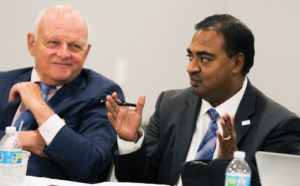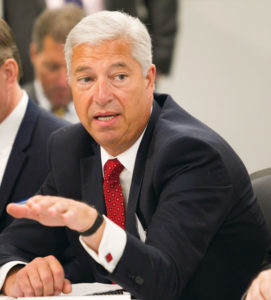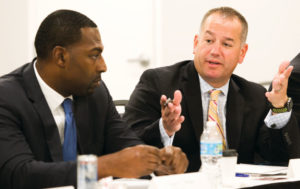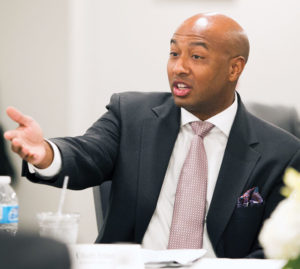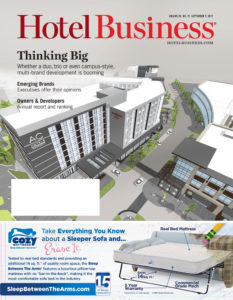Does anyone know what a ‘brand’ is anymore?
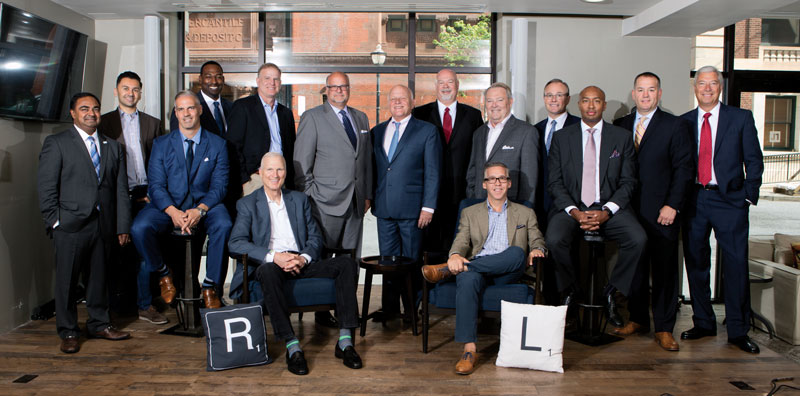
Industry executives and RLHC (Red Lion Hotels Corporation) brass gathered at Hotel RL Baltimore Inner Harbor for the Hotel Business Executive Roundtable.
STANDING, LEFT TO RIGHT: Bhavesh B. Patel, ADM Hotels & Development; Ravi Patel, Hawkeye Hotels; Brad Rahinsky, Hotel Equities; Isaac Brown, Extended Hospitality Group LLC; Lou Schaab, Chesapeake Hospitality; Brian M. McSherry, M&R Hotel Management; Steve Van, Prism Hotels & Resorts; Paul Breslin, Horwath HTL; Bill H. Reynolds Jr., MCS Capital LLC/The Marcus Corp.; Larry Spelts, Expotel Hospitality; Elliott Estes, Woodmont Lodging LLC; Kerry Ranson, HP Hotels; and Ben Seidel, Real Hospitality Group
SITTING, LEFT TO RIGHT: RLHC’s Roger Bloss and Bill Linehan
BALTIMORE—Shuffle through a pile of press releases and the term “emerging brand” will frequently make an appearance. While this term has dominated the industry as hotel companies seek to appeal to the next generation of travelers, the true meaning of what can be called an “emerging brand” is up for debate—and that’s worth discussing.
Held last month at Hotel RL Baltimore Inner Harbor—a 130-room property housed in the historic Keyser Building, offering views of Charm City’s Inner Harbor—the 2017 Annual Hotel Business Owners and Developers Roundtable, hosted by RLHC (Red Lion Hotels Corporation), welcomed panelists from across the industry to discuss the concept of emerging brands, how the proliferation of emerging brands is impacting business, and funding and financing issues with developing properties sans brands. Arthur J. Gallagher & Co. R.E. and Hospitality Services and Sobel Westex sponsored the roundtable, which consisted of 15 panelists in total.
The discussion’s moderator, Stefani C. O’Connor, executive news editor at Hotel Business and managing editor of roundtables, quickly challenged the panelists to define “emerging brand.” The query prompted varying opinions from participants, and Bill Linehan, EVP and CMO at RLHC—whom RLHC hired more than three years ago to assist with brand awareness and hotel revenue technology initiatives—took the first stab and limited the term to new-entrant brands.
“I think new-entrant brands offer choice,” Linehan said to his fellow panelists. “They offer differentiation from what is existing out there in terms of the norm. It doesn’t mean that existing brands are not conforming to be emerging. I think most of them are, but it’s interesting in that emerging brands offer two things: To consumers, they offer more choice, more choice that fits a traveling persona, and to hoteliers, they offer an opportunity for more inventory, which is offering more [choice for the]consumer.”
Other panelists pointed out how emerging brands have been appropriately customizing experiences. These brands have figured out ways to find additional opportunities to tailor to guests’ needs. “What’s cool about emerging brands, or any brand that’s reinventing itself, is this idea of getting closer to the customer and their specific needs, whatever that segment is,” said hospitality veteran Paul Breslin, managing director at Horwath HTL, a global hospitality consulting firm. These emerging brands are doing their own research in advance, which gives them an advantage over legacy brands, who—by virtue of already being established—can’t start from scratch.
“They’re looking at the customer, or that niche, and kind of wrapping the brand around a demographic, and I think that’s the difference,” said Brian M. McSherry, COO at M&R Hotel Management, a Great Neck, NY-based hotel management company. “The difference is instead of moving to the customer, we’re creating for the customer.”
One way emerging brands have been targeting demographics (particularly age demographics—or demographics with a particular “mindset”) is through social media efforts. Brad Rahinsky, president and CEO of Hotel Equities, an Atlanta-based development and management company, said, “I think they are hitting a nerve, or hitting some white space that is really identifying and aligning with today’s traveling consumer. To that point, though, I also think that the legacy brands are seeing that, and they are adapting.”
But participants also voiced concerns around how emerging brands have been developing themselves around a particular age demographic. “What happens when the customer grows up, and they evolve, and they’re no longer in that emerging brand or that particular product?” McSherry asked. “What happens to the investment we made?”
Bill Reynolds Jr., senior managing director at MCS Capital LLC, The Marcus Corp.’s hotel investment business, agreed with McSherry and other panelists on how brand certainty is now about providing individuated experiences (in other words, the Hotel RL in Brooklyn offers something different than the Hotel RL in Washington, DC). However, he also acknowledged efforts by designers, particularly how they’ve taken the fear of guests aging out of properties into consideration by introducing more movable parts.
“I think that the designs are so clever today,” said Reynolds, who has more than 25 years of experience in commercial real estate, specializing in lodging. “If you look at this lobby upstairs, or you think about The Envoy if any of you have been to it up in Boston—it’s a stage set. There’s nothing architectural to do later, so when you want to reinvent it, it’s like changing the scenery on stage, which is very clever on the part of designers. I think that’s how you’re able to keep it fresh, keep it new, keep it interesting.”
It’s that adaptation where emerging brands are finding themselves ahead, even from a developer’s standpoint. “For us, it’s the ability to change quickly and to fit into that demographic as they grow, and so it allows us to localize from market to market, allows us to change quickly on a dime, whereas the past brands, potentially at times, came so built into a box that it was tough, it was cost prohibitive and it also made the consumer go and try different things,” said 25-year industry veteran Kerry Ranson, chief development officer at HP Hotels, a third-party party management company based in Birmingham, AL. “And so the emerging brands—the smart ones—are allowing the adaptation and are allowing for that in the future.”
Ravi Patel, president of Hawkeye Hotels, a property management company in Burlington, IA, offered his take on catering toward a particular age demographic, using the millennial generation as an example. “To some degree, there’s a negative connotation around that, not only to the millennials, like people of my age, but also to old guys like Roger [Bloss, EVP/president of global development at RLHC],” Patel said with a smirk. “We might want to stay at the same hotels, right? Everyone is looking for that exceptional experience. I know when Roger and I talk about hotels we like to stay at, many times those are the exact same.” A few panelists responded to Patel’s comments by suggesting alternative verbiage: using the term “psychographic” instead of “demographic.” This play on words has been common within the industry (think about how often “millennial mindset” is used instead of “millennial”).
In agreement with his fellow panelists, Patel continued: “Seeing that the independents are taking off and accelerating at a pace that’s way faster than many of these brands—it’s precisely that because all of us, whether it’s Gen X, Y, baby boomers—we all want the same thing, and many times these independent brands provide that for us.” For him, the next evolution in the industry is brands elevating experience for all.
Loosening up brand standards enables owners to deliver their own input, and that’s what emerging brands have been doing—creating less restrictive standards that don’t dictate what a guestroom needs to look like, as long as it’s consistent with the brand’s vibe. Lifting requirements on owners can encourage collaboration. “I think, at some point, the more established brands within a franchise are going to begin to pick off the stuff that’s working, and then leave back the stuff that’s not, so it’s going to start to get embedded into more traditional brands. But I think it’s that letting the reins go that’s been valuable,” said Lou Schaab, CFO at Chesapeake Hospitality, a third-party hotel management company headquartered in Greenbelt, MD.
Of course, a property’s hotel brand (or brands) isn’t the only brand to consider. Industry veteran Steve Van, president and CEO of Dallas-based Prism Hotels & Resorts, a hospitality management and consulting company he founded in 1983, redefined “brand” in a way to provoke a larger conversation around how properties—including those without a brand—are gaining traction through unconventional means.
“The competitive advantage the brands have always had was information,” Van pointed out to the panel. “You know, you didn’t have the internet. Remember those days? But now, the biggest brand in every market is TripAdvisor… That’s a bigger brand than Marriott.”
Hospitality groups have been trying to find their place in all of this by wrapping “collections” around independent properties—thereby allowing these properties to maintain their “independent spirit” while also enabling them to leverage the benefits of being associated with a hospitality group. What this means, Van said, is branding is getting lost. He pointed to an emerging soft-brand project his company is currently working on, and noted, “They’re trying to say to the consumer, ‘We’re not a brand, so use our brand.’”
Emerging brands also understand technology and how to use it to enhance the guest experience without impeding stay simplicity. “Technology is a big part of these emerging brands,” said AAHOA chairman Bhavesh B. Patel, also a principal at ADM Hotels & Development. “The older brands really need to focus on technology and making sure they’re heading in that direction as well.” Some of these solutions worth looking into include mobile check-in and social boards, panelists said.
Technology goes both ways, however; emerging brands are also using disruptive technology behind the scenes to pinpoint the consumer as well, and they’re not afraid partner. “The independents, let’s be honest, they have the ability and the freedom to go and work with companies that are finding ways to find our consumer,” Ranson said. “We have the bricks and mortar. They have found the way to find our consumer. The brands, and especially the larger ones, are stuck on these dinosauric components that cannot find the consumer. They can’t feed the consumer what they want. They can’t find the consumer that’s looking for a certain experience at a certain time.”
Traditional brands have a more difficult time keeping up with technological advancements than emerging brands because of the red tape associated with legacy systems—many of which have been developed and upgraded over many years, creating a fragmented platform—not to mention the scale that most of these brands have, making across-the-board change a longer process than if they had a handful of properties. “You look at how it takes a Marriott organization to move the gigabits in a hotel from 50 to 100 and what they have to do with owners and contracts to make that happen,” McSherry said. “An emerging brand or an independent can just say, ‘Bring your guy in and make it happen.’ These types of hotels, you know, they’re targeted, but they’re also more reactive to what our customers are looking for change.”
One challenge that some panelists saw with emerging brands was the competitive creep within a market. Having an area of protection (AOP) is important to owners, but new brands facilitate more competition on a hotel’s street corner, which could cannibalize the brand’s CRS contributions. “There’s a little bit of greed in that,” McSherry said. “That’s where [brands]make their money. They don’t make money necessarily on fees, although it’s hard to believe how you can’t make money on the amount of fees that they charge, but let’s call a spade a spade in that hotel companies, to some degree, need to keep themselves moving in a profitable nature and creating brands is the best way to do it.”
The difference between traditional brands and independent properties could be that the latter has realized there’s a “certain sacrifice to profit,” said Elliott Estes, founder of Woodmont Lodging LLC, a Bethesda, MD-based hospitality investment firm. Reducing revenue per available foot or revenue per available room to be able to host social events is an example, he said, acknowledging how the use of the space would be non-revenue generating.
“I think when you’re designing for the psychographic profile that would really buy into the emerging brand, there’s a certain sacrifice that you have to have to profit,” Estes explained.
Pushing back, Linehan, who’s helped develop and launch a range of lodging brands, injected another component into the equation: competition. “If it’s just measuring what’s the most successful and, therefore, that’s all I’ll build, then we would only have one brand,” he said, noting there’s rivalry among brands resulting from the objective to acquire consumers through authenticity and differentiation—but there’s more to it than that.
“As brands are concerned, we’re also not just competing for the consumer, but we’re also competing for the hotelier,” Linehan said. “While the brand needs to be relevant to the consumer, it needs to be relevant to the hotelier to also participate as a stakeholder in that chain.”
From an investor’s point of view, a property’s profitability cannot be overlooked, however; those putting down the money want to see the ROI. The “warm and fuzzy stuff” alone won’t cut it, McSherry responded frankly.
Thirty-year hospitality veteran Ben Seidel, president and CEO at Real Hospitality Group, a hotel management company based in Ocean City, MD, opined about the relationship between brand equity and consistency. For instance, the way McDonald’s has been able to replicate its menu across the globe—many companies have tried emulating that, he noted. That’s what brands have typically aimed for, standards across all locations—now uniqueness is in.
Referencing the opportunities and challenges with technology, Seidel offered that while the focus on technology may be what’s driving emerging brands forward, it also can be impeding their overall growth. “When you design something that’s all around tech, you better have a 10% FF&E reserve because every year you’re going to be spending every bit of that to keep it valid and vibrant—it’s too easy to become a dinosaur,” he explained. He also questioned how well independent properties would be doing if it wasn’t for the OTAs.
In some ways, traditional brands have been emulating the appeal of OTAs for independent properties by offering to soft brand properties—giving these hotels frameworks to build upon and distributions to leverage while maintaining some of their independence. “The challenge for the RLs of the world, and everyone else who’s coming out with these emergent, lifestyle, experiential brands, is overcoming the need for consistency,” said Larry Spelts, president and chief development officer at Expotel Hospitality, a New Orleans-based management company. “The reason that has to be overcome is because the investor wants that security, but consistency is the enemy of uniqueness in a brand—so how does an emerging lifestyle brand remain unique from location to location so that someone who has stayed at one, and then stayed a second time, will want to stay a third time?”

Hotel RL Baltimore Inner Harbor’s lobby, where participants met before walking over to Aggio Baltimore for cocktails and dinner
For his part, Seidel posed a question for the brand executives in the room: “You’ve obviously done a tremendous amount of research on this. What’s the criteria of brand anymore?”
“We have this debate constantly,” Linehan responded. “Is a brand a brand after a magical number of distribution points? A brand is essentially a personality, so one hotel can be a brand. It’s just how strong is the brand? The more points of distribution, the more it resonates with a larger consumer set, the stronger the brand power is. It doesn’t mean having weak brand power means you have a weak brand; it’s all about flow-through, it’s all about location. Take one of these independent hotels and put it in a rural setting. Well, it doesn’t have the demand, so it’s not going to have the same production as it does in a first-tier city such as New York or even Baltimore.”
He continued, “For us, a brand is a resonance with consumers, and the strength of the brand is how much consumers resonate with that brand.”
Brands set expectations for both lenders and guests, and that’s where soft brands come into play. These soft brands are the emerging brands, AAHOA’s chairman declared, pointing out how properties are still able to maintain independence, the social aspect and the lifestyle aspect through soft brands. Some panelists expressed approval of his assessment of brand progression.
The emphasis on TripAdvisor scores may become more pronounced in the future. Seidel offered, “You want to really soft brand?… You can do whatever you want as long as you maintain a TripAdvisor rating in the X percentile of your product, your fee base is predicated on how well you’re doing there and your default is based on that as well. That’s a soft brand.”
Hawkeye Hotels’ president weighed in, adding his thoughts on soft-brand properties and rate—the sky’s the limit. He also emphasized earlier points of a soft-brand setting expectations for a financial institution for providing comfort to management companies. Soft brands do, however, take up more time and energy, mainly due to the fact the properties are less programmatic, he said.
“I think it’s more a degree of excellence,” he said. “As we see the brands start tiering these soft brands, which we already see—whether it’s Autograph and Tribute, or Curio and Tapestry—you’ll start seeing that happening to some degree of what level of excellence you’re having, what level of service and amenities are we seeing.”
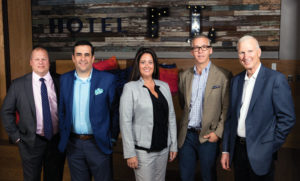
LEFT TO RIGHT: Roundtable sponsors gather for a photo—Scott Arnim, Arthur J. Gallagher & Co.
R.E. and Hospitality Services; Walter Pelaez, Sobel Westex; Jackie Collins, Arthur J. Gallagher & Co.
R.E. and Hospitality Services; Bill Linehan, RLHC; and Roger Bloss, RLHC
Putting on his AAHOA hat, ADM Hotels & Development’s principal expressed the interest of many of the hotel owners association’s developers: Many are now focusing on soft brands. “They’re moving away from these standard brands, and they’re moving toward these soft brands because they know they have a little bit of support behind them.
“And some of them are not even doing the soft brand,” he added. “They’re just going into urban markets because they know they have the distribution channels from the OTAs.”
Another advantage to soft branding a property is that design requirements aren’t necessary, potentially saving properties up to $20,000 a room in renovation costs, McSherry pointed out. “I don’t think the brands get it,” he said, but Bloss pushed back a bit on McSherry’s comments by using Hotel RL’s concept as an example.
“That’s an important point for us because the Hotel RL brand that we have distributed across the country gives owners all of that creativity and individuality as they build them and redo them, but what we’ve created is signature moments at the hotel,” he said. “Things we know are really important to guests—the mobile check-in, the television, the showerhead—are what we focus on as our brand standards, but we leave the rest of it to the owner.”
In addition to providing the property with creativity, Hotel RL also provides the financing, the back of house, the distribution and the loyalty programs. “Quite frankly, when you do the math, you can’t do it as an individual more cost-effectively than we can do it as a brand,” Bloss said.
Is the industry on brand overload? For developers, it doesn’t make much of a difference. “I’ll be honest, from my perspective, I don’t really care,” Hawkeye’s president said. “We like the new brands coming out.” For him, new brands are opportunities, particularly in markets with high occupancy.
Comparing the hotel industry to the music industry, Estes explained, “Labels don’t introduce emerging artists; they acquire emerging talent. I don’t think an established brand can introduce an emerging brand… They’re just targeting consumers to get them into these channels. I think it’s contrived. I think from a consumer’s perspective, they don’t care. I think they just want to go to Marriott and figure out what’s in that channel and do it.”
The proliferation of brands also perplexes investors, many of whom, in return, will demand more than just a vision from hospitality groups. Uncertainty is the enemy. Following Estes’ comments, McSherry added his take: “If I’m investing in a hotel, I’m a little confused—because the brand comes to me and says, ‘I want to do a Fairfield Inn.’ What does Fairfield then do? Well, 96% occupancy at a $260 rate. I understand that, but when you come with an emerging brand or something brand new I say, ‘Well, what does it do?’ ‘Well, it has the potential.’ That scares me.”
As the discussion came to a close, Issac Brown, president and CEO at Extended Hospitality Group LLC, a National Harbor, MD-based company, brought up a timely topic—exit strategy, and what it means to the investor. “My exit strategy and how things are going to turn out for my investors and ROI at the end of the day, that’s very important to me,” he said, noting the consistency brands have when it’s time to sell a property—that’s something to consider when evaluating new brands being introduced into the market.
“I’m responsible for that, and that means my butt’s on the line and my son’s butt’s on the line because it’s a transition,” he said. “It has to be attractive.” HB
Check out our video interviews at video.hotelbusiness.com

